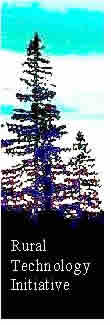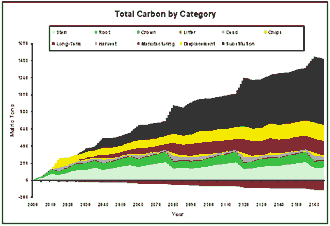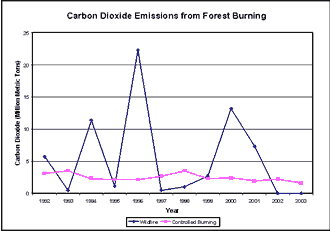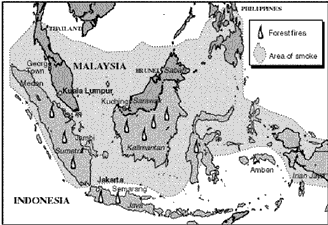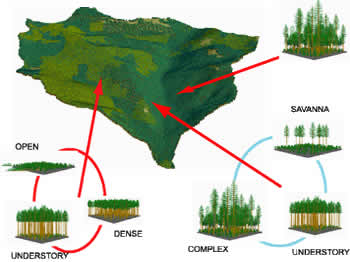 |
 |
 |
 |


Summer 2004, Volume 4, No. 4
Table of ContentA PDF copy of this Newsletter is available here!
|
The Life Cycle of Wood Plays an Important Role in Reducing Carbon EmissionsConcerns over global warming are increasing interest in the emission, sequestration, and storage of carbon. Forests play an important role in the carbon cycle. Through photosynthesis, trees utilize carbon dioxide from the air to grow, removing carbon from the atmosphere and storing it for long periods of time. Some of that carbon can then be transferred to forest products through harvest and manufacturing. Wood products used in housing construction generally last a long time, producing an increasing pool of stored carbon. In addition, using wood products precludes the use of alternative materials such as steel and concrete, the manufacturing of which requires burning fossil fuels that release carbon from the earth into the atmosphere. With this in mind, forest management that includes harvesting timber to create wood products may keep more carbon out of the atmosphere than no-harvest alternatives. To truly measure the potential for forests to counter global warming, a life-cycle analysis is needed that accounts for carbon during all stages of regeneration, materials processing, construction, and product or building use. The carbon life-cycle analysis first accounts for all processes that increase or decrease the amount of carbon in the forest or that move carbon from the forest to other stages. Processes that increase carbon include growth of the stem, roots, and crown of all tree species. Reforestation and afforestation are important occasions of new growth. Processes that release carbon to the atmosphere include the decomposition of snags, logs, roots, and litter, as well as combustion during fire events. Carbon changes in the soil and understory vegetation may also be significant in some circumstances. Mortality shifts carbon from living trees to snags or logs. Similarly, silvicultural operations can shift carbon from living trees to snags, logs, or products. Carbon must be tracked as it enters or leaves each one of these categories, which are called Carbon Pools. When wood products are removed from the forest, the carbon stored in the wood will continue to be stored in lumber and mill byproducts. Carbon stored in products is only released as the products decompose, which depends on the life cycle of the |
product. Lumber used in construction
can store carbon for a 100 years or longer. Wood byproducts
such as hog fuel or other low-valued residuals can be burned
in a wood boiler to generate bio-energy. This precludes the
use of an equivalent amount of fossil-energy (e.g. diesel, coal,
or natural gas), reducing net carbon emissions. The replacement
of fossil-energy with bio-energy is termed ‘displacement,’
which is a key carbon pool. Similarly, if lumber is used as a construction material, steel and concrete are not used, and therefore do not need to be manufactured. This permanently avoids the carbon emissions from the fossil fuels used to manufacture each material, which can be a significant amount of carbon. This is another important carbon pool known as ‘substitution.’ When forest management alternatives are investigated using this carbon life-cycle analysis, the significance of the product, displacement, and substitution pools becomes apparent. The product and substitution pools from a management alternative that includes harvest, may store more carbon than an alternative without harvest. In ecosystems where disturbances can be expected, such as forests with high fire risk, products will likely store carbon for a longer period than the forest would. Finally, because of the permanent benefits of avoiding the carbon emissions from fossil fuel use, substitution and displacement are very important, especially in the long-term. It is important to consider a complete carbon life-cycle when evaluating different management and policy alternatives. RTI has incorporated life cycle research on wood products into the Landscape Management System to provide a complete accounting of carbon pools from forest regeneration through processing, construction, and ultimate demolition. The Consortium for Research on Renewable Industrial Materials (CORRIM) has recently published a life cycle study on wood products in the June 2004 Forest Products Journal. Copies are available for download at www.CORRIM.org.
- Bruce Lippke & Jeff Comnick, RTI - |
Carbon Credits – The Lakeview ExperienceLake County is located in South Central Oregon near the California and Nevada borders. Lake County forests naturally burned at low intensity on a 15-25 year interval and were dominated by large, widely-spaced Ponderosa Pine. In 2002 a study completed by the Rural Technology Initiative showed that 77 % of the Fremont National Forest is in high to medium fire hazard condition and that when a fire does occur it is likely to be catastrophic in nature. Our recent fire history shows this to be true on a 2-3 year interval we are experiencing 200,000 acres of catastrophic fires. These conditions were brought on by forest management policies that focused on aggressive fire suppression and logging of large old-growth trees. Consequently, forest composition and natural fire disturbance regimes have been dramatically altered. Combined with a decade of drought conditions, this has resulted in increased insect infestations and high fuel loads. The 2002 study showed that restoring the Fremont National Forest to natural stand conditions and fire regimes would require an extensive thinning and under-burning program that would yield tremendous volumes of small diameter material. The only economically proven technology that could consume this large volume would be a biomass plant. In December 2003 Lake County Resources contracted with CH2M Hill to develop a business plan and preliminary engineering for a biomass plant. Going into the project we knew that most biomass plants are uneconomical under today’s electrical prices. We decided to look at what influence carbon credits, energy credits and Forest Service Stewardship contracts would have on the economics of a biomass plant. In the State of Oregon any new fossil fuel power plant being built must mitigate for the carbon dioxide (CO2) emissions. In neighboring Klamath County, a 600 megawatt (MW) natural gas plant is being proposed, and the reported CO2 mitigation expense is going to be approximately $12-14 million. The 2002 study by the University of Washington showed that by thinning to restore natural stand conditions versus a wildfire would save 41 metric tons/acre of carbon from going into the atmosphere over a 30-year period. In Oregon, between 1992 and 2001 (the last year data is available), CO2 emissions from uncontrolled forest wildfires ranged from a low of 0.5 million metric tons/year in 1993 and 1997 to a high of 22.3 million metric tons in 1996 (Figure 1). It is our goal to obtain recognition of carbon credits for reducing conditions that lead to catastrophic fire events. In the case of the Fremont National Forest, that would be a |
savings of 41 metric tons of carbon/acre or in CO2 equivalents, 145 metric tons of carbon dioxide per acre. This estimate includes carbon storage in the forest, displacement value of using biomass over natural gas, and product substitution. Our biomass business plan showed that at current electrical prices, a 15 MW plant would be $11 million in the red at the end of 20 years. Much of the cost is in the fuel, which for a 15 MW plant that is approximately $3 million/year for biomass from forest thinnings. Assuming that a catastrophic fire event kills approximately 50% of the trees, if we could get $3/metric ton of CO2 as a credit, this would amount to a $218/acre to assist in reducing fuel costs to the plant (.50 x 145 metric tons/acre x $3/ton).
The carbon credits, combined with the provisions outlined under the Stewardship Contracts allowed under the Healthy Forest Restoration Act, now make a biomass plant economical. Depending on assumptions, a 7-20% return on investment could be anticipated. The Landscape Management System (LMS) can perform all of these calculations and provides a monitoring system for verification of credits. We have buyers interested in these credits, if we can get the EPA to review and accept the science behind LMS. The science community also needs to accept the total forest/product carbon cycle outlined in the CORRIM report (http://www.corrim.org and associated articles in this newsletter). Reducing CO2 emissions into the atmosphere, producing renewable energy and making our forests healthy again seems like a winner to us. We will keep you informed as this project progresses. - James K. Walls, |
Where There’s Fire There’s SmokeIn 1997, a widespread series of uncontrolled fires in Indonesia burned close to 40 million acres of drought-stressed tropical forest. By comparison, in 2002 (a record year for forest fires in the United States) approximately 7 million acres were burned. A blanket of thick, smoky haze spread over a large portion of Southeast Asia. Pollution levels reached all-time highs, closing schools and airports and causing tens of thousands of people to seek treatment for respiratory illness. Dramatic short-term health problems, including fatalities, were experienced by at-risk groups such as children, the elderly, and asthmatics. The potential long-term health problems caused by exposure to smoke pollution may not be known for years. 70 million people were affected. Following such large, well-publicized wildfire events, the general public as well as the scientific community are becoming more aware that emissions from forest fires represent a serious and enduring environmental impact.Smoke is made up of tiny particles, gases, and water vapor. Water vapor makes up the majority of smoke, but the remainder includes carbon monoxide, carbon dioxide, nitrogen oxide, formaldehyde, benzene, and other irritant compounds, toxics, and small particles. Known health effects from smoke exposure can range from burning eyes, runny nose, and bronchitis to congestive heart failure and emphysema. The United States Environmental Protection Agency (EPA) establishes National Ambient Air Quality Standards (NAAQS). It is not uncommon for western communities located within the “wildland urban interface” to experience extended periods of time where smoke from forest fires causes air quality to exceed EPA NAAQS and pose health hazards. |
While the greatest public health concerns have centered around
the fine particulate matter (see http://www.epa.gov/ttn/naaqs/pm/pm25_index.html) Unfortunately the many health impacts associated with forest fire smoke are not generally considered as a public cost (liability) caused by a failure to treat forests to reduce fuel loads and consequently, wildfire incidence and severity. If these negative impacts (public costs) were fully reflected in the market, there could be high motivation to avoid them by making investments to remove excessive fuel loads similar to investments that are made to reduce other forms of air pollution such as industrial smoke emissions.
|
- Technology Update -New smoke model is being used to warn communities of potential health impacts from large wildfires Smoke from wildfires affects air quality. A collection of government and university scientists brought together as the Fire Consortium for the Advanced Modeling of Meteorology and Smoke (FCAMMS) have been working to develop predictive capabilities for anticipating the cumulative impacts of smoke from forest, agricultural, and range fires. The result is a new modeling framework called BlueSky, http://www.fs.fed.us/bluesky/. On a nightly basis, BlueSky obtains a regional meteorological forecast and burn information from state and federal agency burn reporting systems. The merging of these data with models of fuel consumption and emission, and dispersion and trajectory models results in a regional |
forecast of smoke concentrations for the next two days. This modeling capability gives fire managers a much improved ability to estimate how much smoke will be produced, to track the actual smoke produced, and to forecast smoke movement for the next several days. BlueSky has been used to help determine firefighting strategies for large wildfires and to warn nearby communities of potential health impacts. Developing modeling technologies like BlueSky, are also helping scientists to better understand and to predict the magnitude of the social, the environmental, and the economic costs associated with wildfire events. Website offers up-to-date fire information The National Interagency Fire Center maintains a very informative web site, that reports current wildfire activity across the nation. The website can be found at http://www.nifc.gov/fireinfo/nfn.html. |
- LMS Update -Inventory Wizard 2.1 – Released July, 2004 Economatic 1.1 with Scenario Analyzer – Released August, 2004 Economatic 1.2 – Available September, 2004 Sort Table Wizard 1.0 – Available September, 2004 LMS 3.0 – Available Fall, 2004 Free downloads available from |
|
 |
Save the Date |
 |
| Saturday September 18, 2004 Family Forest Field Day Francis, WA Contact Steve Gibbs at steve.gibbs Sunday, September 19 - Tuesday, September 21,
2004 *New Date: Saturday November 13, 2004 |
Wednesday, December 8 - Friday,
December 10, 2004 LMS Training Workshop Skagit Valley College, Mt. Vernon, WA Contact Clara Burnett at (206) 543-8684 or clara75 Thursday January 13, 2005
|
Readers may send comments to:Bruce Lippke, Director RTI
|

